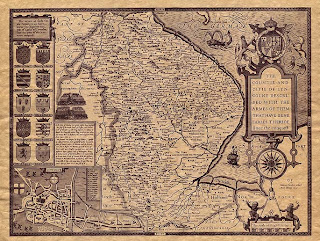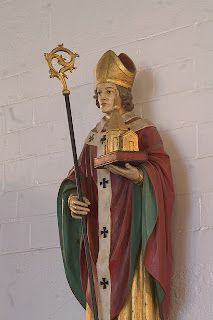A Brief History of Catholic Lincolnshire
1. St. EUSTACE WHITE
CATHOLIC MARTYR & PRIEST
b. 1560 - d.1591
Martyred at Tyburn for
being Catholic.
Feast Day 25th
October
St Eustace White was one of the Catholic Forty Martyrs of England and Wales. Born in Louth, Lincolnshire in 1559, he was a convert to Catholicism who travelled to Europe to study for the priesthood. He was ordained at the Venerable English College, Rome in 1588, and returned to England for his ministry later that year; the year of the Spanish Armada.
The new stained glass window at St. Mary's Catholic Church Louth depicting St Eustace White.
Fr. White was
imprisoned in London on 18th September 1591 where for 46 days he
was kept lying on straw with his hands closely manacled. On 25th
October the Privy Council gave orders for his examination under torture. Fr
White was tortured by the notorious Topcliffe who suspended him in manacles for
over 8 hours on 7 different occasions. It is reported that the sweat from his
body formed pools under him, such were his agonies.
At the height of his pain he cried out: "Lord, more pain if Thou pleasest, and more patience". And to his torturer he said: "I am not angry with you for all this, but shall pray to God for your welfare and salvation". He also suffered deprivation of food and clothing. On 6th December together with Edmund Gennings, Polydore Plasden, and Swithin Wells he was condemned to death for being Catholic.
At the height of his pain he cried out: "Lord, more pain if Thou pleasest, and more patience". And to his torturer he said: "I am not angry with you for all this, but shall pray to God for your welfare and salvation". He also suffered deprivation of food and clothing. On 6th December together with Edmund Gennings, Polydore Plasden, and Swithin Wells he was condemned to death for being Catholic.
Having been hung by
the neck from the Tyburn Tree he was cut down and then rose to his feet.
As he staggered he was tripped up and dragged to the fire where two men stood
upon his arms, pinning him to the ground, while the executioner butchered him
whilst still conscious. The remains of his body were thrown on to the fire.
He bore this suffering for refusing to deny that the Catholic Church was the one true church established by Christ. He won his crown at Tyburn in 1591, a mere 31 years of age.
ST EUSTACE WHITE – PRAY FOR US
2. THE LINCOLNSHIRE UPRISING.
The Lincolnshire Uprising was a righteous stand by Roman Catholics against the establishment of the Church of England by Henry VIII and the dissolution of the monasteries set in motion by Thomas Cromwell's suggested plan of asserting the nation's religious autonomy and the king's supremacy over religious matters.
It began at St. James Church, Louth, after evensong
on 1 October 1536, shortly after the closure of Louth Abbey. The
uprising was only against the attempt to suppress the religious houses,
these being Catholic, and was not against the king himself. It quickly gained support in Horncastle, Market Rasen, Caistor and other nearby towns.
Angry with the actions of commissioners, the protesters/rioters
demanded the end of the collection of a subsidy, the end of the Ten Articles, an end to the dissolution, an end to taxes in peacetime, a purge of heretics in government, and the repeal of the Statute of Uses. With support from local gentry, a force of demonstrators, estimated at up to 40,000, marched on Lincoln and, by 14 October, occupied Lincoln Cathedral.
They demanded the freedom to continue worshiping as Catholics, and
protection for the treasures of Lincolnshire churches. It was led by a
monk and a shoemaker, and involved 22,000 people.
The moratorium effectively ended on 4 October 1536, when King Henry
sent word for the occupiers to disperse or face the forces of Charles Brandon, 1st Duke of Suffolk,
which had already been mobilised. By 14 October, few remained in
Lincoln. Following the rising, the vicar of Louth and Captain Cobbler,
two of the main leaders, were captured and hanged at Tyburn. Most of the other local ringleaders met the same fate over the next
twelve days, with a lawyer from Willingham being hanged, drawn and
quartered for his involvement. Soon, however, the Lincolnshire Rising helped inspire the more widespread Pilgrimage of Grace.
_____________________
3. ST. AELRED OF RIEVAULX
(1110-1167)
Abbot of Revesby
Abbot of Rievaulx
Born: 1110 probably at or near Hexham, Northumberland
Died: 12th Janury 1167 at Rievaulx Abbey, Yorkshire North Riding
Aelred was one of three sons of Eilaf, priest of St Andrew's at Hexham and himself a son of Eilaf, treasurer of Durham.
Aelred was born in Hexham, Northumbria, in 1110. He spent several years at the court of King David I of Scotland, rising to be Master of the Household before leaving the court to enter the Cistercian abbey of Rievaulx, in Yorkshire, in 1134, at the age of twenty-four. He may have been partially educated by Lawrence of Durham, who sent him a hagiography of Saint Brigid.
.
In 1143 when William, Earl of Lincoln, founded a new Cistercian abbey upon his estates at Revesby in Lincolnshire, St. Ælred was sent with twelve monks to take possession of the new foundation. During his stay at Revesby he met St. Gilbert of Sempringham. Aelred became the abbot of a new house of his order at Revesby in Lincolnshire in 1143, and later, abbot of Rievaulx itself in 1147.
Through his friends and his writings, Aelred became a figure of national importance. Dialogue of the soul is an important work. He was chosen to preach at Westminster Abbey during the translation of St. Edward the Confessor in 1163 and subsequently wrote his well-known life of this man. Other works include a Life of St. Ninian, the Saints of Hexham and Sermons on Isaiah which are often considered his finest.
_____________________
4. BARDNEY ABBEY
Bardney Abbey in Lincolnshire, England, was a Benedictine monastery founded in 697 by King Æthelred of Mercia, who was to become the first abbot. The monastery is supposed to have been destroyed during a Danish raid in 869. In 1087 it was refounded as a priory, by Gilbert de Gant, Earl of Lincoln, and it regained status as an abbey in 1115.
In 1537, six of the monks were executed for their role in the Lincolnshire Rising, and Dissolution followed. In the following year the property was granted to Sir Robert Tirwhit.
He retained the abbot's lodging as a house, and the cloister became a garden, though both later became ruinous along with the remainder of the monastery. Excavations in 1909-14 revealed the layout. This can still be seen, though nothing remains to any height. Some grave slabs and carved stone are preserved in Bardney parish church.
_____________________
5. BARDNEY ABBEY, THE RELICS OF ST. OSWALD & MIRACLES
Bede relates that Bardney Abbey (which he called Beardaneu) was greatly loved by Osthryth, queen of Mercia, and in about 679 she sought to move the bones of her uncle, the very pious St Oswald there. However, when the body was brought to the Abbey the monks refused to accept it, because the Abbey was in the Kingdom of Lindsey, and Oswald, when king of Northumbria, had once conquered them. The relics were locked outside, but during the night a beam of light appeared and shone from his bier reaching up into the heavens. The monks declared that it was a miracle and accepted the body, hanging the King's Purple and Gold banner over the tomb. They are also said to have removed the great doors to the Abbey so that such a mistake could not occur again, so if someone said "do you come from Bardney?", it meant that you had left the door open.
In 909, in response to increased viking raids, Oswald's bones were translated to the new St Oswald's Priory, Gloucester. There is an Irish Catholic Archbishop who holds the title of Abbot of Bardney. He is known as a "Titular Abbot" — one who holds the title of a suppressed or destroyed abbey.
_____________________
6. ST. PAULINUS
St. Paulinus was a Roman missionary and the first Bishop of York. A member of the Gregorian mission sent in 601 by Pope Gregory I to Christianize the Anglo-Saxons from their native Anglo-Saxon paganism, Paulinus arrived in England by 604 with the second missionary group. After some years spent in Kent, perhaps in 625, Paulinus was consecrated a bishop. He accompanied Æthelburg of Kent, sister of King Eadbald of Kent, on her journey to Northumbria to marry King Edwin of Northumbria,
and eventually succeeded in converting Edwin to Christianity. Paulinus
also converted many of Edwin's subjects and built some churches. One of
the women Paulinus baptised was a future saint, Hilda of Whitby. Following Edwin's death in 633, Paulinus and Æthelburg fled Northumbria, leaving behind a member of Paulinus' clergy, James the Deacon. Paulinus returned to Kent, where he became Bishop of Rochester. After his death in 644, Paulinus was venerated as a saint.
At Lincoln, in ancient Lindsey, St.
Paulinus built a small church at the insistence of Blaecca, the
"praefectus" of the city, whom he had converted. Paulinus was consecrated
Archbishop Hon St.
Paulinusorius of Canterbury here in AD 628.
The church was St. Paul's-in-the-Bail, erected in the centre of the ruinous
Roman Forum. Along with St. James the Deacon, he baptised in the Trent
at Littleborough.
_____________________
.jpg)






No comments:
Post a Comment